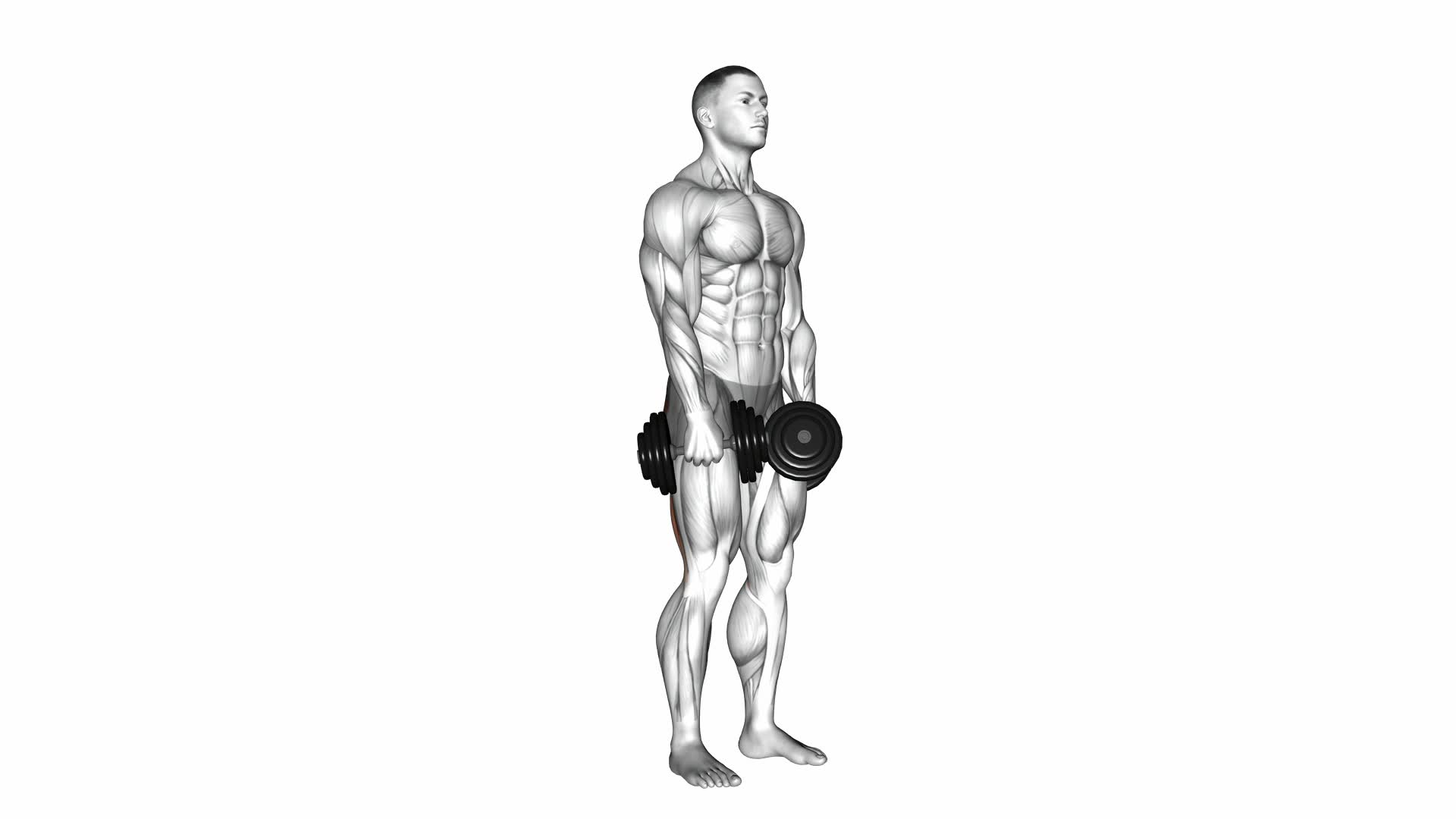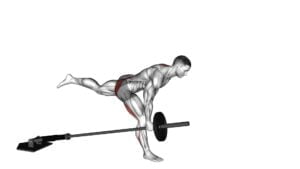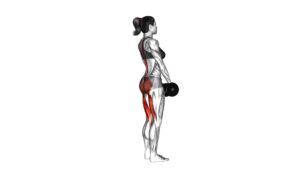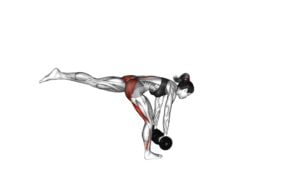Dumbbell Stiff Leg Deadlift – Video Exercise Guide & Tips

Are you looking to strengthen your hamstrings and glutes? The dumbbell stiff leg deadlift is a great exercise for you!
Watch This Exercise Video
This video exercise guide will show you the proper form and technique to maximize your results. You'll learn about the muscles targeted by this exercise and discover variations to keep your workouts challenging.
Avoid common mistakes and get tips for a more effective workout. Get ready to take your fitness to the next level with the dumbbell stiff leg deadlift!
Key Takeaways
- Dumbbell stiff leg deadlift targets multiple muscle groups, including hamstrings, glutes, and lower back.
- Proper form and technique, such as engaging core muscles and maintaining a straight spine, are crucial for effective and safe execution.
- Engaging glutes effectively is key to maximize the benefits of the exercise.
- To avoid lower back strain, it is important to maintain proper form, control the movement, and gradually increase weights.
Benefits of Dumbbell Stiff Leg Deadlift
To maximize your gains and strengthen your posterior chain, performing dumbbell stiff leg deadlifts can be incredibly beneficial. This exercise targets multiple muscle groups, including the hamstrings, glutes, and lower back, making it an effective workout strategy for maximizing results.
One of the key benefits of dumbbell stiff leg deadlifts is that they help improve hamstring flexibility and strength. By performing this exercise, you engage your hamstrings in a lengthened position, which can enhance your overall athletic performance and reduce the risk of lower body injuries. Additionally, by keeping your legs straight throughout the movement, you activate your glutes more effectively, leading to stronger and more defined buttocks.
Another advantage of dumbbell stiff leg deadlifts is their ability to strengthen your lower back. This exercise not only targets the erector spinae muscles but also engages the deep stabilizing muscles of the spine. As a result, it can help improve your posture and reduce the risk of back pain.
To get the most out of your dumbbell stiff leg deadlifts, it's important to maintain proper form. Keep your core engaged, hinge at the hips while keeping a slight bend in your knees, and focus on feeling the stretch in your hamstrings as you lower the dumbbells. Gradually increase the weight and intensity as you become more comfortable with the exercise.
Proper Form and Technique
To perform the dumbbell stiff leg deadlift with proper form and technique, it's essential to maintain correct back posture throughout the exercise. Engaging your glutes effectively is crucial for targeting the right muscles and maximizing the benefits.
It's also important to avoid lower back strain by keeping the weight close to your body and using a controlled, smooth motion.
Correct Back Posture
Maintain proper back posture by engaging your core and keeping your spine straight during the dumbbell stiff leg deadlift exercise. This is crucial for preventing back pain and injury while maximizing the benefits of the exercise.
Here are three important factors to consider:
- Strengthen Your Core: Engaging your core muscles not only helps to stabilize your spine but also improves your overall balance and control during the movement. This can help reduce the risk of straining your back muscles.
- Keep Your Spine Straight: Avoid rounding or arching your back during the exercise. Imagine a straight line running from your head to your tailbone. This alignment ensures that the load is evenly distributed and reduces stress on your spine.
- Maintain a Neutral Neck Position: Keep your neck in line with your spine, looking forward rather than up or down. This helps to maintain the natural curvature of your spine and prevents unnecessary strain on your neck and upper back.
Engaging Glutes Effectively
Are you effectively engaging your glutes during the dumbbell stiff leg deadlift exercise? Glute activation is crucial for maximizing the benefits of this exercise and preventing injury.
To engage your glutes effectively, it's important to focus on proper form and technique. One key aspect is mastering the hip hinge technique. Start by standing with your feet hip-width apart, holding the dumbbells in front of your thighs.
Keep your back straight and core engaged as you slowly hinge forward at the hips, pushing your glutes back. Lower the dumbbells along your shins until you feel a stretch in your hamstrings. Engage your glutes and core to lift your body back to the starting position, using your hips to drive the movement.
Avoiding Lower Back Strain
Engage your core and maintain proper form to avoid lower back strain during the dumbbell stiff leg deadlift exercise. Lower back pain is a common issue that can occur if you don't use the correct technique. Preventing injuries should be a priority when performing this exercise.
Here are three important tips to help you avoid lower back strain:
- Keep your back straight and hinge at the hips: This ensures that the load is properly distributed and reduces the stress on your lower back.
- Control the movement: Avoid using momentum and focus on a slow and controlled descent. This helps to engage the muscles properly and reduces the risk of injury.
- Use an appropriate weight: Start with lighter dumbbells and gradually increase the weight as your technique improves. This allows your muscles to adapt and reduces the strain on your lower back.
Muscles Targeted by the Exercise
Target three major muscle groups with the dumbbell stiff leg deadlift. This exercise primarily engages your hamstrings, glutes, and lower back. By focusing on these muscles, you can build strength and improve your overall lower body stability.
The dumbbell stiff leg deadlift is a versatile exercise that can be modified to target different muscle groups. One variation is the single-leg stiff leg deadlift, which increases the activation of your hamstrings and glutes. This variation also challenges your balance and coordination.
To perform the dumbbell stiff leg deadlift, stand with your feet shoulder-width apart, holding a dumbbell in each hand. Keeping your back straight, hinge forward at the hips while maintaining a slight bend in your knees. Lower the dumbbells towards the ground while maintaining a neutral spine. Engage your hamstrings and glutes to return to the starting position.
Incorporating the dumbbell stiff leg deadlift into your workout routine can help you achieve stronger and more defined hamstrings, glutes, and lower back. Remember to start with lighter weights and gradually increase the load as you become more comfortable with the exercise. Proper form and technique are crucial to maximize the benefits and minimize the risk of injury.
Variations of Dumbbell Stiff Leg Deadlift
To continue exploring the dumbbell stiff leg deadlift, let's now look at some variations that can add even more challenge and effectiveness to your workout routine. It's important to remember that proper form is crucial for maximizing the benefits of these variations and minimizing the risk of injury.
Here are three variations of the dumbbell stiff leg deadlift that you can incorporate into your workouts:
- Single-leg dumbbell stiff leg deadlift: This variation adds an extra level of difficulty by requiring more balance and stability. Stand on one leg while holding a dumbbell in the opposite hand. Hinge at the hips and lower the dumbbell towards the ground while keeping your back straight. Return to the starting position and repeat on the other leg.
- Romanian dumbbell stiff leg deadlift: This variation focuses more on the hamstrings and glutes. Start by holding the dumbbells in front of your thighs with your palms facing your body. Hinge at the hips, keeping your back straight, and lower the dumbbells towards the floor. Pause when you feel a stretch in your hamstrings, then return to the starting position.
- Sumo dumbbell stiff leg deadlift: This variation targets the inner thighs and glutes. Start with your feet wider than shoulder-width apart and your toes turned out at a slight angle. Hold the dumbbells in front of your thighs with your palms facing your body. Hinge at the hips, keeping your back straight, and lower the dumbbells towards the floor. Pause when you feel a stretch in your inner thighs, then return to the starting position.
Remember to always prioritize proper form when performing these variations to ensure you get the most out of your workout and minimize the risk of injury.
Common Mistakes to Avoid
One common mistake to avoid when performing the dumbbell stiff leg deadlift is rounding your back. This is a crucial mistake that can lead to injury and should be avoided at all costs. Rounding your back places excessive stress on the spinal discs and can result in lower back pain or even herniated discs. To prevent this, focus on keeping your back straight throughout the entire movement. Engage your core muscles and imagine a straight line from your head to your tailbone.
Another common mistake is using too much weight. It's important to start with a weight that you can handle with proper form. Using too much weight not only decreases the effectiveness of the exercise, but it also increases the risk of injury.
Additionally, avoid a jerking or swinging motion during the exercise. This not only reduces the effectiveness of the exercise but also puts unnecessary stress on the lower back. Keep the movement controlled and smooth, focusing on using your hamstrings and glutes to lift the weights.
Tips for Maximizing Your Results
To maximize your results with the dumbbell stiff leg deadlift, it's important to focus on proper form. This exercise targets your hamstrings and glutes, so make sure you engage those muscles throughout the movement.
Additionally, effective workout strategies such as gradually increasing the weight and incorporating supersets can help you achieve better results.
Lastly, consistency is key – make sure to perform this exercise regularly to see the best outcome.
Proper Form Importance
Using proper form is crucial for maximizing your results when performing the dumbbell stiff leg deadlift. The importance of technique can't be overstated, as it not only helps you target the right muscles but also ensures that you avoid injury.
Here are three key reasons why proper form is essential:
- Muscle Activation: Proper form allows you to engage your hamstrings, glutes, and lower back effectively, leading to better muscle activation and growth. This will help you achieve your desired results faster.
- Injury Prevention: Performing the dumbbell stiff leg deadlift with incorrect form puts unnecessary strain on your lower back and can lead to injuries like herniated discs or muscle strains. Proper form helps you maintain a neutral spine and distribute the load evenly, reducing the risk of injury.
- Functional Strength: By maintaining proper form, you mimic movements that are similar to everyday activities, enhancing your overall functional strength and making daily tasks easier.
Effective Workout Strategies
To maximize your results while performing the dumbbell stiff leg deadlift, it's important to incorporate effective workout strategies.
One key strategy is managing your workout intensity. By gradually increasing the weight of the dumbbells or the number of repetitions, you can challenge your muscles and promote growth. However, it's crucial to avoid overexertion, as this can lead to injury.
Another important strategy is time management. Allocate a specific amount of time for your workout and stick to it. This helps ensure that you complete all the necessary exercises and maintain consistency in your training.
Consistency for Best Results
To maximize your results and achieve the best possible outcome, it's essential that you maintain consistency in your workouts. Consistency is crucial because it allows your body to adapt and progress over time.
Here are three reasons why consistency is important for maximizing your results:
- Consistency builds momentum: When you establish a regular workout routine, it becomes easier to stay motivated and focused on your goals. Consistently showing up for your workouts creates a positive feedback loop that keeps you moving forward.
- Consistency improves performance: By consistently challenging your body with regular workouts, you allow your muscles, cardiovascular system, and overall fitness to improve. Over time, this leads to increased strength, endurance, and overall performance.
- Consistency enables progress tracking: When you maintain a consistent workout routine, it becomes easier to track your progress and make adjustments as needed. By monitoring your performance and making necessary changes, you can ensure that you're continually pushing yourself and achieving optimal results.
Frequently Asked Questions
How Much Weight Should I Use When Performing the Dumbbell Stiff Leg Deadlift?
When performing the dumbbell stiff leg deadlift, it's important to consider the weight recommendations for optimal results.
The amount of weight you should use depends on your fitness level and goals. Start with a weight that challenges you but allows you to maintain proper form throughout the exercise.
As you progress, you can gradually increase the weight to continue challenging your muscles.
Can I Perform the Dumbbell Stiff Leg Deadlift With a Barbell Instead of Dumbbells?
Yes, you can perform the dumbbell stiff leg deadlift with a barbell instead of dumbbells.
However, there are benefits to using dumbbells for this exercise.
Dumbbells allow for a greater range of motion and more control over the movement, which can help target your glutes, hamstrings, and lower back more effectively.
Additionally, using dumbbells can help improve stability and balance.
Is It Necessary to Have a Weightlifting Belt When Doing the Dumbbell Stiff Leg Deadlift?
When performing the dumbbell stiff leg deadlift, you may wonder if wearing a weightlifting belt is necessary. The answer depends on your personal preference and comfort level.
While a weightlifting belt can provide extra support to your lower back, it isn't mandatory for this exercise. Proper form is key to preventing injury, regardless of whether you choose to wear a weightlifting belt or not.
Focus on maintaining a neutral spine and engaging your glutes and hamstrings throughout the movement.
Can I Perform the Dumbbell Stiff Leg Deadlift if I Have Lower Back Pain?
If you have lower back pain, it's important to be cautious when performing the dumbbell stiff leg deadlift. This exercise puts a significant load on your lower back, which can aggravate your pain.
It's recommended to modify the exercise or choose alternative exercises that provide relief for your lower back.
Speak with a fitness professional to learn about dumbbell stiff leg deadlift modifications or alternative exercises for lower back pain relief.
How Often Should I Incorporate the Dumbbell Stiff Leg Deadlift Into My Workout Routine?
To effectively incorporate the dumbbell stiff leg deadlift into your workout routine, consider your goals and current fitness level.
This exercise targets the hamstrings, glutes, and lower back, so it's important to give your muscles adequate rest and recovery time.
You can perform this exercise 1-2 times per week, alternating with other hamstring exercises like Romanian deadlifts or glute bridges.
This will help prevent overtraining and maximize the benefits of the dumbbell stiff leg deadlift.
Conclusion
In conclusion, the dumbbell stiff leg deadlift is an effective exercise for targeting the muscles of the lower body, particularly the hamstrings and glutes.
By maintaining proper form and avoiding common mistakes, you can maximize your results and reap the benefits of this exercise.
Incorporating variations into your routine can also help to keep your workouts challenging and prevent plateauing.
Remember to always prioritize safety and consult with a fitness professional if needed.

Author
Years ago, the spark of my life’s passion ignited in my mind the moment I stepped into the local gym for the first time. The inaugural bead of perspiration, the initial endeavor, the very first surge of endorphins, and a sense of pride that washed over me post-workout marked the beginning of my deep-seated interest in strength sports, fitness, and sports nutrition. This very curiosity blossomed rapidly into a profound fascination, propelling me to earn a Master’s degree in Physical Education from the Academy of Physical Education in Krakow, followed by a Sports Manager diploma from the Jagiellonian University. My journey of growth led me to gain more specialized qualifications, such as being a certified personal trainer with a focus on sports dietetics, a lifeguard, and an instructor for wellness and corrective gymnastics. Theoretical knowledge paired seamlessly with practical experience, reinforcing my belief that the transformation of individuals under my guidance was also a reflection of my personal growth. This belief holds true even today. Each day, I strive to push the boundaries and explore new realms. These realms gently elevate me to greater heights. The unique combination of passion for my field and the continuous quest for growth fuels my drive to break new ground.



